The Relationship between Gold and Crude Oil Price
Commodities / Crude Oil Dec 20, 2012 - 01:34 AM GMTBy: P_Radomski_CFA
 In the financial markets, gold is usually ascribed to the commodities category. In this group of assets you will find your good old friend, silver, along with several others metals like platinum, palladium, copper etc. Apart from that, commodities encompass a broad range of other products in the like of corn, but also crude oil, gas, minerals and other. Such groups of assets are usually traded on commodity exchanges specialized in this kind of products, for instance on the Chicago Mercantile Exchange or the London Metal Exchange.
In the financial markets, gold is usually ascribed to the commodities category. In this group of assets you will find your good old friend, silver, along with several others metals like platinum, palladium, copper etc. Apart from that, commodities encompass a broad range of other products in the like of corn, but also crude oil, gas, minerals and other. Such groups of assets are usually traded on commodity exchanges specialized in this kind of products, for instance on the Chicago Mercantile Exchange or the London Metal Exchange.
Commodities differ from stocks or bonds in the fact that, usually they have significant importance for some industry. For example, silver is used in the production of electrical conductors and oil is used as fuel for various kinds of machines. The main difference from a financial point of view is that, other than bonds and stocks, commodities do not give you cash flows in the like of dividends, coupons or the principal. The only way in which commodities generate returns (excluding industrial applications) is when their price changes in the direction you bet on.
Since price changes are of crucial importance for commodities investors, relationships between these commodities are often examined in detail to establish if prices of one commodity can fuel prices of another. It is, for instance, almost universally acknowledged that there is a strong relationship between prices of gold and silver, where the price of silver strongly depends on the price of gold.
Most precious metals investors have probably analyzed the gold to silver ratio more than once in their investment career, but such relationships can be found not only between metals. It is argued that prices of gold and oil are also related. Higher price of oil would translate in higher prices of gold. Since there is no apparent intuitive connection between what happens with oil and what happens with gold, there is need for some explanations here.
The main idea behind the gold-oil relation is the one which suggests that prices of crude oil partly account for inflation. Increases in the price of oil result in increased prices of gasoline which is derived from oil. If gasoline is more expensive, than it’s more costly to transport goods and their prices go up. The final result is an increased price level – in other words, inflation. The second part of the causal link is the fact that precious metals tend to appreciate with inflation rising (in the current – fiat – monetary environment). So, an increase in the price of crude oil can, eventually, translate into higher precious metals prices.
To see if this is actually the case, let’s take a look at the chart below. It presents prices of gold and Brent crude oil in the 1987-2012 period.
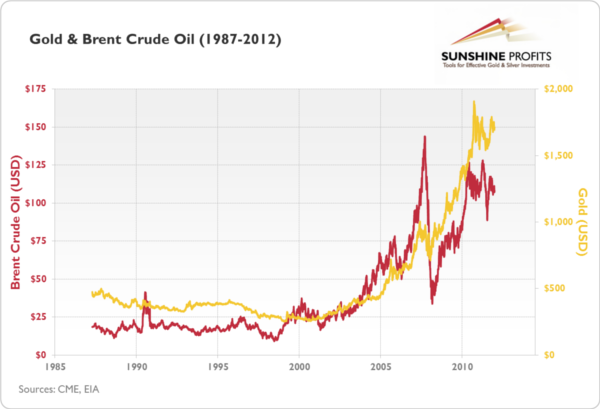
As it turns out, both commodities tend to trade in the same direction. The relationship is far from perfect but it seems to be there. We have measured this relationship by calculating the R-squared for gold and crude oil in the above-mentioned period. R-squared is a statistical measure, but you don’t need to be a rocket scientist or have a Ph.D. in Mathematics to understand it. The basic idea is simply that if you have two quantities (e.g. price paths), R-squared shows you how much of the changes in one of those quantities can be explained by the other quantity. To put it simple, in our case R-squared shows you how much of the changes in the price of gold can be explained by changes in the price of crude oil. The result is 78.7% which, quite intuitively, tells you that, in fact, price levels of gold and crude oil are strongly related. This is further confirmed by another chart.
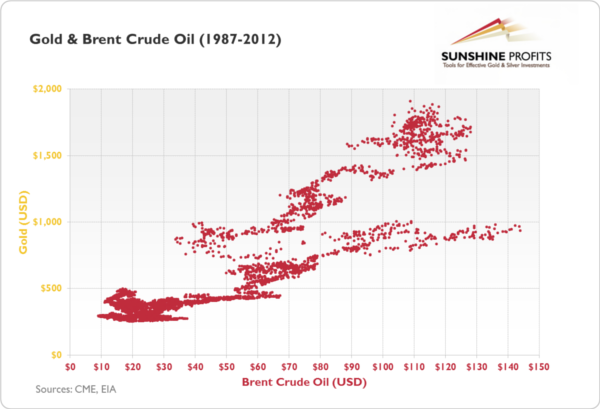
On this chart, we have plotted prices of gold in relation to prices of Brent crude oil. This chart can be interpreted in the following way: the horizontal axis shows you the price of oil on a given day and the vertical axis shows the price of gold on the same day. So, if you look at the horizontal axis and find oil at, say, $70, looking up in a straight line will tell you what gold cost when oil was at $70. We see that the cloud of points is generally rising in the price of oil. This suggests, just as the previous chart did, that there is a relation between the two price levels: higher prices of oil coincide with higher prices of gold.
One puzzle here is that it usually takes some time for higher oil prices to materialize as higher prices in goods and services. But it does not seem to take too long for gold you have in your portfolio to trade in line with oil. One explanation can be that, once oil appreciates, precious metals investors discount the expected future higher prices o goods in the price of gold and gold goes up.
With such results on the table, it would be tempting to proclaim that you can trade this relationship. But to see if this is really the case, we’ll turn to a different chart.
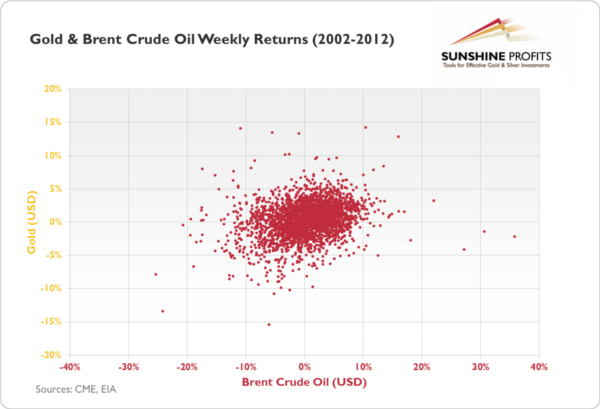
This chart is similar to the previous one but it differs from it in two ways: we plot weekly gold and oil returns instead of prices and we shorten the analyzed period to start with the year 2002. The results here are completely different than before. The cloud of points does not seem to reveal any coincidence or relationship – it does not follow any visible trend and the points look like plotted randomly in the middle of the chart, around 0% returns for both gold and oil. R-squared suggests that 7.2% of the changes in gold returns can be explained by changes in oil returns. The conclusion might be that higher weekly oil returns don’t necessarily imply anything meaningful for weekly returns of gold as far as long-term analysis is concerned. We have obtained similar results for daily, monthly and quarterly returns.
The main point is that, even though the general price level of gold evolves in a similar direction to oil, the relationship may not be tradable based on data for the long term. Over longer periods of time and on average, opening long speculative positions in gold based on expected appreciation of oil may simply not be profitable.
Having said that, it’s still possible for short-term patterns to emerge occasionally. So, even though there seems to be no relationship between gold and oil returns over the long term, it may happen that a relationship unveils itself in a short period of time offering trading opportunities.
A popular way to analyze gold in terms of crude oil is the gold:oil ratio in which the price of gold is divided by the price of oil. We present historical levels of the ratio along with prices of gold on the chart below.
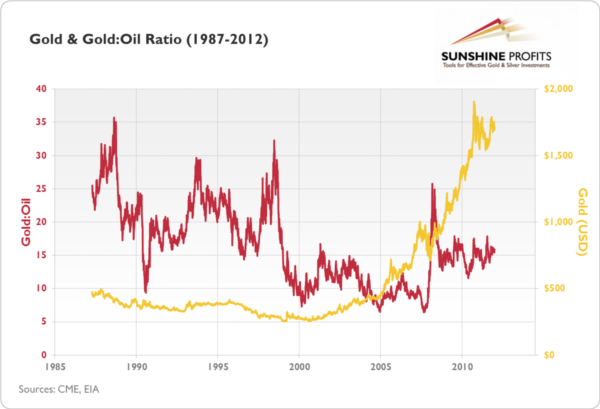
Peaks in the ratio signalize periods when gold was expensive relative to oil. Troughs point out periods when gold was relatively cheap compared with oil. The ratio does not reveal any striking patterns or relationships. As is with charts, it can be interpreted differently by different persons. Quick calculations yield an R-squared of 3.4%, which suggests that the ratio on its own may not have any particular impact on gold prices at the same point in time.
In light of the mixed results obtained so far, we have checked the relationship between gold and oil price levels for stability. We have calculated R-squared values for gold and oil prices in a one-year window for each day in the 1987-2012 period (subject to data availability). The results are presented on the chart below.
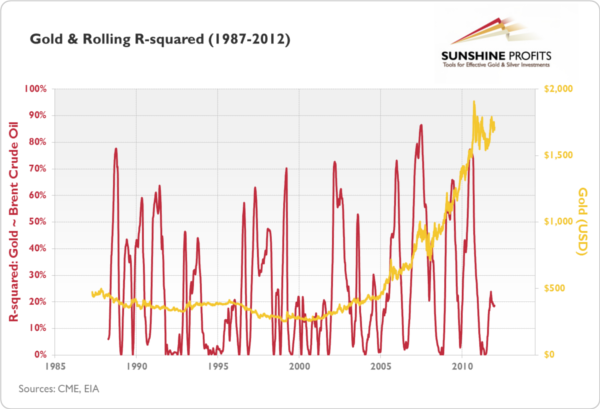
The red line shows the R-squared values calculated in a one-year window ending on the day for which the value is shown. The changes in the R-squared can be perceived as the stability of the gold-oil relationship. High values indicate that for a one-year period prior to the day for which the value is reported the link between gold and oil was relatively strong and they traded in the same directions. Low values indicate that for one year the relationship was questionable and gold and oil traded independently. We can see that the stability of the relation has been fluctuating dramatically for the last 25 years.
It is considerably difficult to find any apparent relationship between the behavior of R-squared values and the price of gold. To check for any such link, we have applied two thresholds to the R-squared values. The first threshold would be one that was broken when R-squared went up. The other one was one that was broken when R-squared was declining. We have checked for different values of the thresholds, values that would coincide with highest or lowest past returns of gold. Altogether, we have answered four questions:
- If the R-squared was going down, what threshold would have coincided with highest returns?
- If the R-squared was going down, what threshold would have coincided with lowest returns?
- If the R-squared was going up, what threshold would have coincided with highest returns?
- If the R-squared was going up, what threshold would have coincided with lowest returns?
The answers:
- For R-squared going down, a threshold of 63.8% would have coincided with monthly returns of 5.4%.
- For R-squared going down, a threshold of 80.8% would have coincided with monthly returns of -7.2%.
- For R-squared going up, a threshold of 81.1% would have coincided with monthly returns of 10.8%.
- For R-squared going up, a threshold of 86.2% would have coincided with monthly returns of -11.0%.
Even if the above might seem slightly complicated, they imply two straightforward points:
- When the relationship between gold and oil was strong but deteriorating, gold returns tended to be considerably low.
- When such a relationship was significant and strengthening, gold returns tended to be extreme – either considerably high or considerably low.
The above results do not imply that such relationships were tradable. But they point out that the degree to which gold and oil traded in the same direction could have had influence on gold returns.
To sum up, there seems to be a relatively strong relationship between gold and oil prices but not between gold and oil returns. The strength of the relationship between gold and oil coincides with high or low gold returns. This relationship may not be useful for speculation over the long term but it’s possible that patterns emerge locally, in short time spans. Results of our analysis of the relationship between gold and oil show that if you are considering entering the gold market and the relationship between gold and oil is strong but deteriorating, you may want to double check the current situation on the market. Additionally, if you are to enter the market and the above-mentioned relationship is strengthening, this could coincide with considerable movements in gold to either side. You might want to check additional factors to confirm which side it might be.
If you would like to get more information on how oil can be related to precious metals, please read our gold, silver and oil trio report. If you want to get to know more about other topics connected to gold and silver, try our series of reports on gold and silver.
Thank you. Have a great and profitable week!
To read the complete version of this study that is 12 times bigger. Go to gold & silver investment website SunshineProfits.com and sign up for free. You'll find it under Premium Updates.
Thank you for reading. Have a great and profitable week
Przemyslaw Radomski, CFA
Founder, Editor-in-chief
Gold & Silver Investment & Trading Website - SunshineProfits.com
* * * * *
About Sunshine Profits
Sunshine Profits enables anyone to forecast market changes with a level of accuracy that was once only available to closed-door institutions. It provides free trial access to its best investment tools (including lists of best gold stocks and best silver stocks), proprietary gold & silver indicators, buy & sell signals, weekly newsletter, and more. Seeing is believing.
Disclaimer
All essays, research and information found above represent analyses and opinions of Przemyslaw Radomski, CFA and Sunshine Profits' associates only. As such, it may prove wrong and be a subject to change without notice. Opinions and analyses were based on data available to authors of respective essays at the time of writing. Although the information provided above is based on careful research and sources that are believed to be accurate, Przemyslaw Radomski, CFA and his associates do not guarantee the accuracy or thoroughness of the data or information reported. The opinions published above are neither an offer nor a recommendation to purchase or sell any securities. Mr. Radomski is not a Registered Securities Advisor. By reading Przemyslaw Radomski's, CFA reports you fully agree that he will not be held responsible or liable for any decisions you make regarding any information provided in these reports. Investing, trading and speculation in any financial markets may involve high risk of loss. Przemyslaw Radomski, CFA, Sunshine Profits' employees and affiliates as well as members of their families may have a short or long position in any securities, including those mentioned in any of the reports or essays, and may make additional purchases and/or sales of those securities without notice.
Przemyslaw Radomski Archive |
© 2005-2022 http://www.MarketOracle.co.uk - The Market Oracle is a FREE Daily Financial Markets Analysis & Forecasting online publication.



